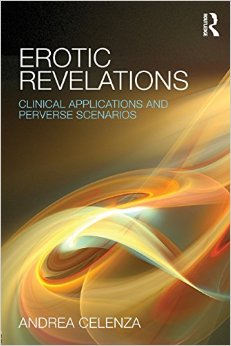 EROTIC REVELATIONS: Clinical Applications and Perverse Scenarios by Andrea Celenza, Ph.D. Hove, East Sussex : Routledge, 2014.
EROTIC REVELATIONS: Clinical Applications and Perverse Scenarios by Andrea Celenza, Ph.D. Hove, East Sussex : Routledge, 2014.
This book is about erotic desires and fantasies, how our sexuality expresses our inner being and defines the ways in which we engage in the psychoanalytic situation. I am using erotic life in its broadest sense – the way we desire and love or desire to be loved on all levels, including within our sexual being. We are drawn to the hidden and mysterious; we are tempted to push boundaries, even in the most permissive contexts. Erotic experience exemplifies this urge. What is the nature of this push, this urge to get beyond the immediate and concrete? What are we looking for, what does it feel like? These are some of the questions that pertain to the present exploration into erotic life in the psychoanalytic and psychotherapeutic situation.
In large part, this book addresses the ‘desexualization’ of the psychoanalytic field and proposes several reasons for this phenomenon. It is, in part, an attempt to explain and correct this desexualization, along with offering recommendations to practitioners for dealing with erotic material when it arises. For example, it has been said that psychoanalysis is all about sex; except for sex – that’s about aggression. This workshop aims to ‘put sexuality back in psychoanalytic theorizing’ in both early formulations (as in the maternal erotic) and to delineate a place for pure erotic longing, along with the illustration of the variety of forms of homo-erotic and hetero-erotic desires. My focus on the erotic nature of the therapeutic situation is an effort to reclaim sexuality as one of the many nexes that are of central concern to our patients. At the very least, I am asserting that erotic transferences of whatever shape, should make their way into every thorough-going analysis or therapy.
Throughout the book, the framework of felt-experience (embodiment), multiplicity, and contradictory gender theory is employed to propose ways in which binarial constraints (e.g., feminine and masculine) may be transcended. I propose that symptoms, inhibitions, and anxieties often result from the individual’s unconscious overcommitment to one pole of the masculine/feminine binary, rather than a more balanced reckoning with the social and cultural demands associated with each.
The book is written in two parts, with clinical, theoretical, and technical discussions in each chapter. Part I presents the varieties and meanings of erotic transferences and countertransferences that are common in clinical situations. Each chapter focuses on a different manifestation, along with thorny technical dilemmas that confront the psychoanalytic clinician. Case illustrations of erotic material are used as examples of phases in treatment as well as moments of defensive impasse. These include the management of aggression, underlying merger fantasies, the uses of countertransferences (in multiple forms), and the dilemmas surrounding self-disclosure. There are cases of both genders and the likely scenarios that emerge when the analyst is female are emphasized. Process material is examined from both classical and contemporary perspectives in terms of theoretical understanding and technical considerations. Countertransference difficulties, including the handling of erotic countertransferences are discussed.
In Part II, the chapters focus on ‘perverse scenarios’ with the aim of reconceptualizing and restoring the term perversion into the clinical lexicon. By viewing perversion as a quality of relating rather than a specific action or behavior, the term is both narrowed and reformulated so that it may be (paradoxically) more broadly applied. I define perversion as characterized by the impact of its constriction and constraint, the hidden and unbidden (Stoller, 1986). Fundamental to the construction of perverse modes of relating is a means/end reversal (Stein, 2008), i.e. the use of constructive means for destructive purposes (either to the self or the other). Finally, I discuss the clinical observation that perverse modes of relating by males are often aimed at a perceived dangerous subjectivity of the other while females tend to perceive a dangerous subjectivity within. These dangers can be understood as organizing, delimiting, and unconsciously choreographing the dual capacities of receptivity and potency. Perverse scenarios can be viewed as unconscious enactments that serve to manage and control some imbalanced reckoning with this binarial construction and the ways in which the polarities have come to define one’s embodied and gendered subjectivity. Finally, I propose a schema of perverse scenarios that categorize 1) the localization of perceived dangers (within oneself or in the other), 2) the context (either dyadically or triadically conceived), and 3) degrees of severity (where a rigidly enacted perverse scenario may come to serve a transitional function as the individual’s capacities for growth expand).
About the Author
Andrea Celenza, PhD, is a Training and Supervising Analyst at the Boston Psychoanalytic Society and Institute, Faculty at the Massachusetts Institute for Psychoanalysis and an Assistant Clinical Professor at Harvard Medical School. She has authored and presented numerous papers on the evaluation and treatment of therapists who have engaged in sexual misconduct with a focus on training and supervisory issues. Her book, Sexual Boundary Violations: Therapeutic, Supervisory and Academic Contexts, was published by Jason Aronson in 2007. She has recently produced an online videorecorded lecture on sexual boundary violations designed for ethics seminars, group viewing or individual use. Dr. Celenza is Co-Director (with Martha Stark, MD) of a blended, online program in Psychoanalytic Psychotherapy sponsored by William James College (formerly Massachusetts School of Professional Psychology). She has been the recipient of several awards, including the Karl A. Menninger Memorial Award, the Felix & Helena Deutsch Prize and the Symonds Prize. She just completed a new book: Erotic Revelations: Clinical Applications and Perverse Scenarios, published by Routledge. She is in private practice in Lexington, Massachusetts.

